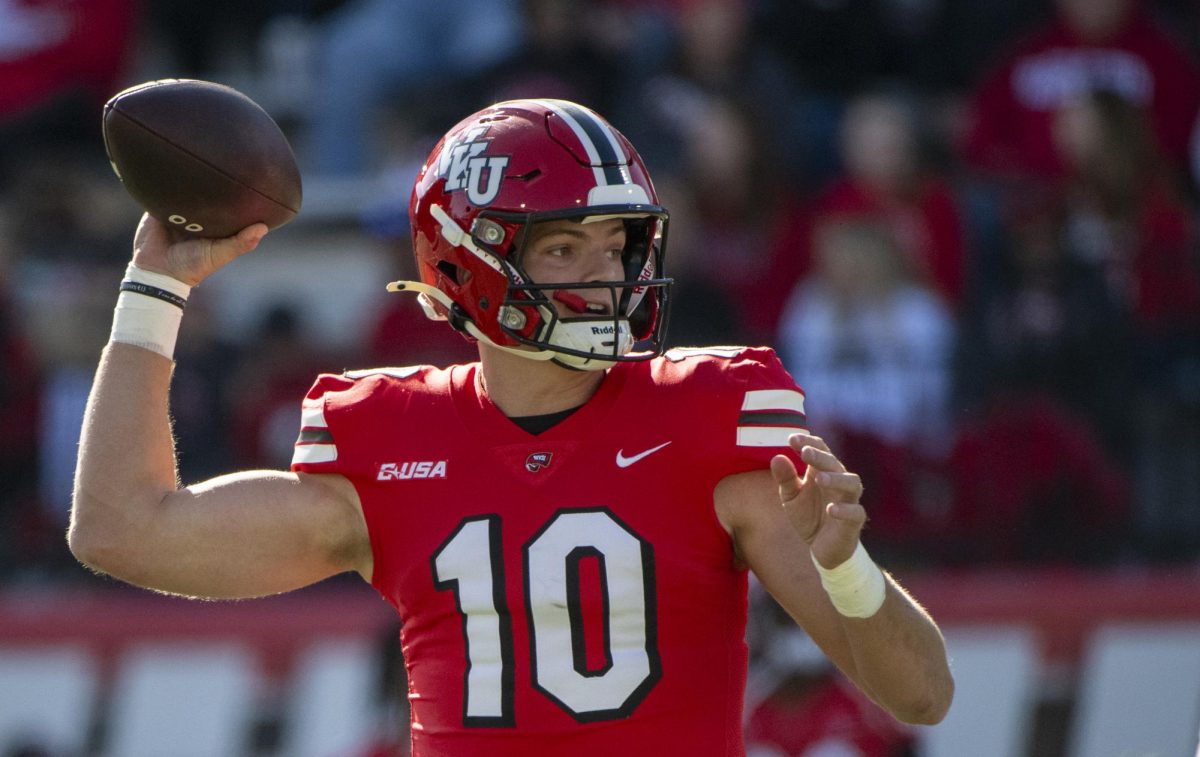Then & Now
October 24, 2002
Some things change.
Every year, former Western students come back to the Hill to see the places they slept, played and studied. They look to see if life at Western is just as they left it.
But as time goes on, some things change. Buildings are torn down. Renovated. People move. Traditions evolve.
But some things stay the same.
1962
Only a stone arch and benches sit where Bobby Rascoe once called home. A former basketball player for the legendary E.A. Diddle, the 1962 graduate lived in Diddle Dorm during his four years on the Hill.
Long before Kentucky had its Wildcat Lodge, the men’s basketball team slept, showered and hung out in a single dorm.
The building, which was razed in 1994, sat where Diddle Park is now. It housed about 20 players and team managers, who were a stone’s throw away from the gymnasium they played games in – now Helm Library.
“The coach lived in the front part of the dormitory, which was basically a house,” he said.
Having their coach around wasn’t always a pleasantry for the players, Rascoe said. Diddle, who had keys to all their rooms, would check on them in the morning and at night .
“You think it’s a little rough at the time,” Rascoe said.
But it wasn’t always bad.
Players and friends would congregate, in a group of as many as 12 people, on a long, white wooden bench facing near what is now Environmental Science and Technology Hall, Rascoe said.
In the middle of what was then a major thoroughfare through a much smaller campus, the group would talk about games, classes, girls or whatever was the latest news, he said.
But boys will be boys – even in the 1960s.
“The girls would come by and we’d holler at them,” Rascoe said.
A basketball player visiting a girls dorm was big news for the group.
Everyone on the bench would be retelling the basketball player’s story after he returned to Diddle Dorm, Rascoe said.
Sometimes Diddle himself would sit on the bench, yelling out greetings to friends as they strolled by.
But their coach’s presence would change the tone of conversation for the players.
“We kind of cleaned up our act when he was around,” Rascoe said.
– Joseph Lord
1972
Brad Watson’s life was a mix of work and play.
During the fall, Watson, a 1972 graduate, was a defensive end for the
football team.
But during the rest of the year, Watson could be found sitting on the porch at the old Sigma Alpha Epsilon house at 1351 College Street.
It was white with blue trim on the outside. On the inside, it had about a dozen bedrooms in three stories.
The large house, overlooking the rest of the street, was slightly weathered on the exterior. But looks can be deceiving. The old house had it’s own charm on the inside, Watson said.
“I really enjoyed my time in the fraternity,” said Watson, who joined the fraternity during his freshman year. “There was a lot of camaraderie, and we spent a lot of time together.”
Watson said the brothers did chores around the house, but also made time for social gatherings with sororities.
One of Watson’s fraternity brothers, President Gary Ransdell, said the boys always ate breakfast and dinner together at the house.
“Dinnertime was an adventure,” Ransdell said. “. Food fights were known to happen.”
The old house at 1351 has long been sold. It’s now a yellow house with green shutters and white trim.
But the next generation of fraternity brothers aren’t too far away. The fraternity bought a house close to Cherry Hall, near the top of College Street – 1410 to be exact.
The white house, adorned with bronze lion statues at the front steps, bears the purple and gold “SAE” letters above the porch on the building’s facade.
Watson said he’ll be back this weekend for homecoming events, including an SAE reunion.
His life has carried him far away from the Hill. He’s been around the world in the Navy and around the country as a professional football player. He now lives in Franklin, Tenn.
But for Watson, there’s no place like the Hill.
“The thing about Western is that it is still one of the most beautiful campuses I have ever seen. Sitting at the top of the Hill makes for a beautiful place,” Watson said.
– Danny Schoenbaechler and Hollan Holm
1982
Anthony Bowles walked into the Cellar on the ground floor of West Hall and began searching for his friends. The lights were dim as students dressed in Jordache jeans and ‘members only’ jackets jammed into a big study room. The study room had no desks and only a few chairs along the wall. It changed to a dance floor. Earth, Wind and Fire blared from the speakers as students tested their latest moves.
For Bowles, a 1983 graduate, it was a typical Friday night hanging out in the cellar.
“(The Cellar) was a big hangout for African American students long before Nite Class was built,” Bowles said. “If you wanted to meet someone, you knew to hang out between Central and West and you would always find them.”
At the beginning of the school year, black sororities and fraternities would draw for a weekend to sponsor a party in the cellar. They used the parties as fund raisers, usually charging about 50 cents for admission.
The Cellar looked like any dorm study area, but without the tables and desks. A few chairs were set up along the walls where some students would sit and talk.
There weren’t any decorations and the lights were dim.
A deejay set the equipment up in the corner and played hits from bands like Kool and the Gang and the Gap Band. Sugarhill Gang’s “Rapper’s Delight” was a popular song.
But the Cellar wouldn’t last forever. It’s popularity faded in 1988 when Niteclass opened in the Downing University Center.
“The sororities and fraternities still tried to have functions in the Garrett Ballroom, but there was a different atmosphere there,” Bowles said. “It lost a lot of the social atmosphere and the tradition behind it.”
– Jocelyn Robinson
1992
Nikita Stewart never had air conditioning during her four years in dorms on the Hill. A 1994 graduate, Stewart lived in Potter Hall her freshman year.
What is now the office space for Western administrators was once a women’s dorm, complete with large rooms with high ceilings, movable furniture and spacious closets with doors.
Besides enjoying the rooms, Potter Hall was on top of the Hill and near most of the journalism major’s classes in Garrett Conference Center and Gordon Wilson Hall.
The fact that the rooms did not have cable television was not a problem, she said. Without the distraction of TV, Potter residents focused on their studies while in their rooms.
But it wasn’t all work for the students of the early 1990s.
As many as 50 students would gather in the lobby to watch cable television. Some didn’t have a television, and those who did would get few channels and fuzzy reception.
“Everyone watched ‘Cosby’ and ‘A Different World’ before the Thursday parties,” Stewart said.
It was more than just watching the tube, but a social activity. For dinner, they would order out for food at places like Ski Daddy’s.
“They had the best wings,” Stewart said.
When the shows were finished, many of the girls of Potter would go to their rooms and get ready for parties in Nite Class.
Stewart was disappointed when Potter closed as a dorm after her freshman year. No one told the girls the dorms would close until the middle of her freshman year.
Stewart moved into McLean Hall and lived in the same room until graduation.
Not only have the memories and friends stuck with her, but so has one of the minor inconveniences of dorm life. Stewart has never had air conditioning, not even today in her Newark, N.J. home.
– Shawntaye Hopkins
2002
The smell of hamburgers on the grill drifted through the air. Students dressed in jeans and red and white Western t-shirts stood around laughing and talking to each other. Some tossed footballs and frisbees.
Top 40 radio competed against broadcasts of other college football games blaring from car radios.
“A lot of times we attended games and tailgated beforehand. That’s something that really sticks out in my mind…” said Glenn Gittings, a 2002 graduate, of his time at Western. “(My roommates and I) had hamburgers, chicken, that sort of thing. We would grill all day long and toss around footballs. It was fun.”
For Gittings and his three roommates, weekdays were devoted to school and extracurriculars, but weekends were a chance to relax, hangout and watch sports.
On game days, the group would dress in their favorite gray and red sweatshirts before loading a charcoal grill, coolers full of meat and beer, and an old, broken-in football into their cars.
They parked their cars at the football practice field just yards from where the Hilltoppers would battle in a few hours.
“. We would listen to other college games until Western’s pregame stuff started. Then we would switch and listen to that.” said Gittings. “Sometimes local radio stations would be broadcasting near us and that was always interesting.”
Just before the game started, the group would pack their belongings and head over to Smith Stadium. Armed with red towels and school spirit, the group would find a seat in the bleachers and cheer on Western throughout game.
Although he usually went to games with just his roommates, Gittings occasionally hosted pregame cookouts for members of the Student Affairs Graduate Association.
“Tailgating was a good way to get everyone to socialize,” Gittings said.
Although Gittings won’t make it back for Homecoming, typically the tailgating event of the season, he hopes to come back soon.
“Even though I’m no longer at WKU, I’m still connected to it,” said Gittings.
– Clare Lowther











